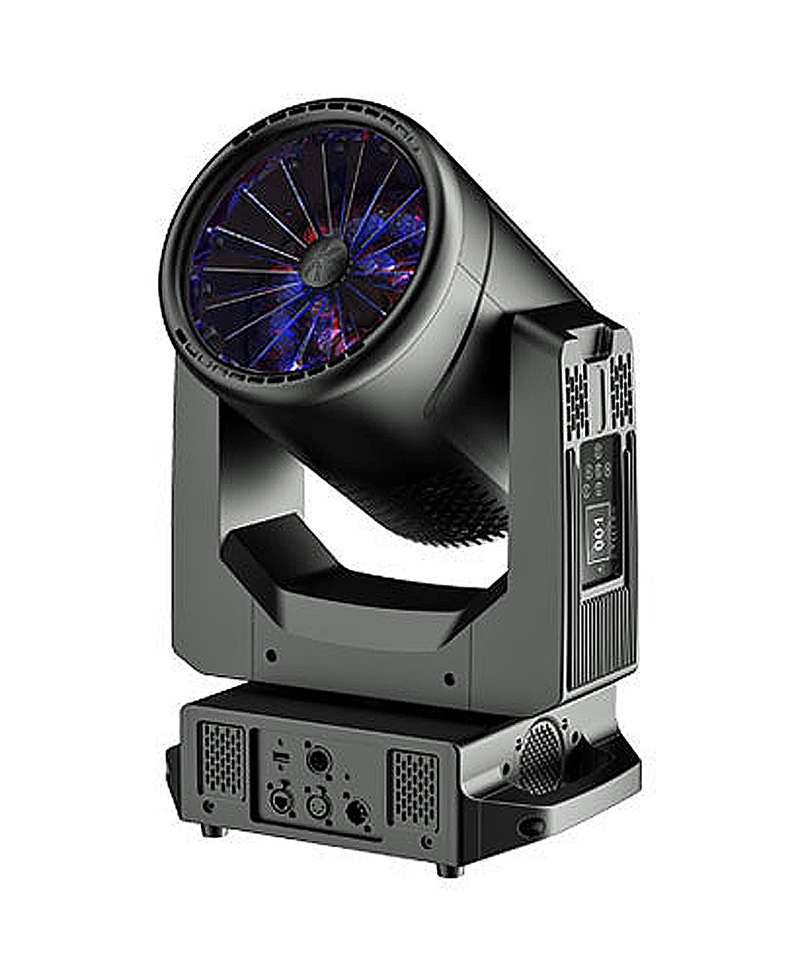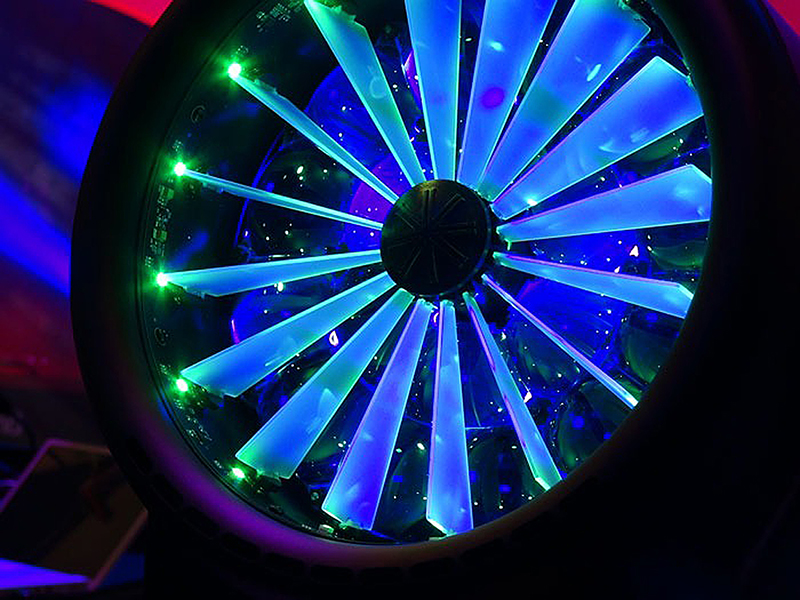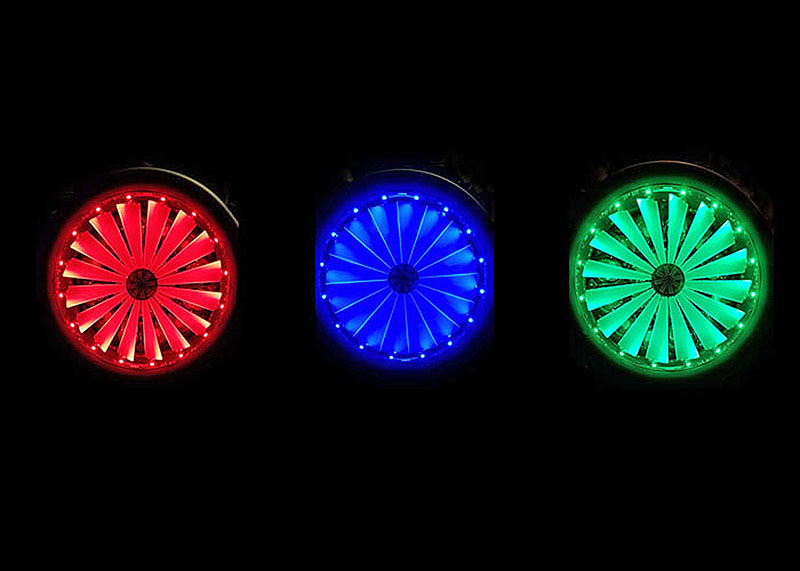
The legendary VL5 was the classic wash fixture — functional, yet sexy in a way no other fixture had been before or since. The color changing system came from a series of blue, amber, and magenta radial mounted dichroic colored blades, and the beam shot out of a reflector. Though limited to a certain range of colors, it was the size of a par can and emulated the shape as well. Over the years, Vari-Lite and its various owners offered several models of this fixture, going from arc light models to different color systems to an 80V Philips lamp. The original version was baseless and light enough that a tech could carry two in one hand.
The physical appearance of the fixture, with its sexy blades, is still so pleasing that companies have tried to copy the look and attempted to recreate this light — including Vari-Lite themselves, with their large-format 6000 series. With all of the darkness 2020 has placed on the globe, I’m here to tell you the VL5 LED is a lovely beacon of innovation that shines through. New innovations, additional eye candy, and an off-the-hook color system demand notice.

The Body and Physical Attributes
First of all, this model isn’t some lightweight fixture anymore. The physical footprint is still small for a 52-pound moving light. It’s under two feet tall and 14 inches wide and can fit tightly in a truss or hide well in any floor nook on a stage. The black ABS cover fits over the aluminum frame and is sleek. The head is basically cylindrical in shape, with fans sucking in air from one side and blowing out the other, unlike the fanless VL5. It is not very loud to start with, but when put in “whisper” mode, I can barely hear it purr.
The fixture moves quite a bit faster than one would expect, and the pan and tilt motors are strong. I can pan the 540° in two and a half seconds. I can actually set the maximum pan angle to be 630° if I wanted. The strength of the pan and tilt motors is such that I wouldn’t hesitate to hang this fixture at any angle. I have a hard time bumping it out of a focus position manually. The fixture executes movement effects, such as a circle, flawlessly and quickly. It’s also not hot to touch; I wouldn’t concern myself with having it close to any set piece.
I fed DMX straight through the 5-pin XLRs, but the fixture can accept RDM, Art-Net and sACN through an RJ45 Ethernet connector as well. 100-240V of AC can be fed through a Neutrik TrueOne connector, and there’s a USB connector for firmware updates. The fixture is capable of drawing up to 1320 watts. The PWM refresh rate is adjustable from 900 Hz to 25 KHz.
Sixteen Dichro*fusion blades replace the original Dichro*tune blades (the original color mixing source), and they are being used as a frost function. They diffuse the light output about 90 percent, I’m guessing, but serve as an excellent source of eye candy as well.
Eighteen 60-watt RGBACL six-in-one Osram LED cells provide the bulk of the light output. The fixture boasts 14,000 lumens of output. With my meter, I’m registering almost 1,500 foot candles from a 20-foot distance.
Besides the main beam emitters, the inside circumference of the fixture is lined with 16 color mixing LEDs that can illuminate the blades themselves. This was an afterthought to building the perfect LED version of this fixture, but they do add a little pizazz. If I put the light beam in blue at 20 percent and turn these LEDs on in red, I get a nice look for scenic applications. I will admit I saw these fixtures used on the Billboard Awards recently, and they made excellent eye candy when not emitting light beams.

Control
This can be a little tricky, as Vari-Lite offers users several ways to play with the fixture. Different modes will have an effect on how well the color system is utilized. Most of these pertain to how you want to control the color. I will preface this next bit by letting everyone know that the 18 cells emitting light cannot be controlled individually, so the beam emitted will always be one solid color. The idea was to upgrade a classic fixture with modern technology, not completely reinvent it.
That said, this fixture is now all about the color. While the classic VL5 brought you some great colors, it was limited in the color mixing arena. Pastel colors were hard to mix in some models, while primary colors were limited in others. I found I can mix almost any color of the rainbow outside of a deep Royal Blue. With the blades popping with absorbed colors, the look of this beam is just magical.
I ran through a few different choices of personalities related to how I will use the color system. Through the six-button, battery operated display, I chose the Open Source mode. In this mode, I can mix colors individually, using seven encoders to adjust the six hues in the cell + CTO. I can see some really particular designers (the ones that have 100 different hues in their color palettes) using this. I then chose to use the fixture in what they refer to as “Smart Color Mode.” In this mode, I have control of just the RGB + Color temperature encoders, though the console knows to use all seven colors when mixing.
I am able to mix a luscious red, a decent blue and a gorgeous green. The shades of yellow are good, with no trace of green pigment, and of course the amber colors that were so prominent in the original are all here as well. The color temperature channel can go from a deep 1800°K up to an ice blue 10,000°K. By taking the color temperature below the defaulted value of 3000°K, one reaches the saturated red color and dark greens usually found only behind solid dichroic filters. When I mix colors, it’s almost as if they are electric. Even basic white sparkles unlike any other fixture I can remember as the vibrant colors seem to bounce off the tips of the blades.
I have to give huge kudos out to Vari-Lite as they sought to keep the old diehard users of this fixture happy by having the LED version emulate the old model. In the original, there was no shutter to black out the beam, and there was always a half second of time that would pass as the bulb itself dimmed. The same was true of color, it just couldn’t bump from one to another fast due to physical liabilities. The fixture profile has actually given me options that I can either default to or set per cue to emulate these old traits. Options such as Snap On or Snap off reflect how you wish the light to work. Theater users may do well to choose the snap off mode in the color time channel to see it behave like the original fixture. Snap On will make the colors and dimmers snap like typical LEDs.
Along with the color mixing, there is a dedicated color channel that acts like a scroller. VL has dedicated, calibrated and vibrant, color presets that run the gamut of the rainbow. I found that I can use these colors just as easily as the mixed colors. If I want to bump from one to another, I can. If I place the control channel for color into “Snap Off” and leave the time at zero, they will fade from one preset color to another in a half second and not scroll through others. Of course, there is a color time channel I was able to use should I wish to have a five second (or longer) fade from one color to another on this dedicated color channel, without scrolling through the other colors between the percentage values on the encoder. The Chrome Orange preset, in particular, is electric to my eye. I have never been able to mix that color on any fixture until now.
I do note that the native CRI of these LEDs is >90. They offer a TM-30 filter that takes it down a few points, and my eye can notice the difference in the color hues and saturation levels. There is also a green/magenta shift encoder that can prove quite handy with camera use.
Each of the 16 Dichro*fusion blades has an RGB LED inside the head’s circumference that illuminates it. Users can take control of each individual LED’s color and dimmer to their hearts fancy. Chase macros are built in for razzle dazzle. Nobody in an arena setting will ever notice these from afar, but the camera picks them up beautifully.
With the old VL5, users had to choose their type of lens for an entire show. The zoom function replaces that and can take the beam from a narrow 8° to its widest — 35°. It can move quickly, and I got some nice shadow play using both the zoom and frost channels in chases simultaneously. However, with this in mind, VL does offer a lens accessory kit that includes a 3° diffusion, 10° diffusion, and 10°x40° lenticular lens, as well as an LED blade diffusion ring.
Dimming-wise, the VL5LED Wash is smooth and linear. The strobe rate can hit 25 FPS and run in Sync, Random, and Sync Random (all lights flash at the same random speed), which is good. The blade LEDs strobe as well. I do miss not being able to randomly strobe the individual cells on the fixture to get a sparkle effect.

At a Glance:
Retro, Yet Advanced
Vari-Lite has succeeded in truly updating the VL5 to a modern fixture, advancing the technology with better mixed and more varieties of colors, tighter movement, perfect dimming, a zoom function and strobing ability.
VL5LED Wash
PROS: Extremely vibrant colors with amazing range of color temperature control, tight movement with no overshoot, great premixed colors and programming options.
CONS: No split color beams
FEATURES
- Compact, High Output LED Wash Fixture
- High CRI RGBALC Color System with SmartColor Control
- Dichro*fusion Diffusion Blades & LED Blade Lights
- Motorized Zoom and Variable Diffusion
- Standard, Studio & Whisper Modes
STATS
- Lamp Source: 18 60W Osram 6-in-1 modules
- CRI: >90
- Output: 14,000 lumens
- Total Wattage: 1320W
- Color Mixing: RGBACL + CTO
- Color Temp Range: 1800°K to 10,000°K
- Zoom Range: 8-35°
- Weight: 52 lbs.
- Size: 23” x 14” x 14”
- DMX channels: 29-81
- IP Rating: IP20
- MSRP: $8,775
Manufacturer: Vari-Lite/Signify
More Info: www.vari-lite.com


